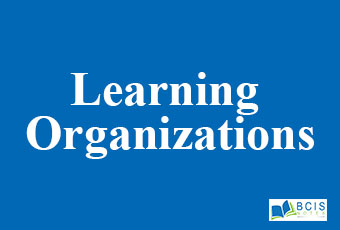
Learning organizations
Concept:
Learning Organizations is another way an organization can proactively manage organizational change. It involves the continuous growth of an organization’s culture. In business management, a learning organization is a company that facilitates the learning of its members and continuously transforms itself. The concept was coined through the work and research of Peter Senge and his colleagues. Learning organizations develop as a result of the pressures facing modern organizations; this enables them to remain competitive in the business environment.
Peter Stage opines: “A learning organization is continually expanding its capacity to create its future”.
The credit of learning organization goes to the influential work of Chris Argyris and his colleagues. They made the distinction between first-order (or single loop) and second-order (or double-loop) learning:
- Single-loop learning
- Double-loop learning
Single-loop learning:
It is focused on improving the organization’s capacity to achieve established (or known) goals/ objectives. Here, in this type of learning, the organization learns without significant change in its basic assumptions. Basically, it is routine and behavioral learning. It is adaptive and short-term oriented.
Double-loop learning:
It highly focuses on re-evaluating the organization’s values, objectives, and beliefs that surround their organization. It contains the change in organizational culture. Double-loop learning consists of the “organizations learning how to learn”. It is generative learning and long-term-oriented.
Difference between Traditional organizations and Learning Organizations:
| Functions | Traditional Organizations | Learning Organizations |
|---|---|---|
| Determination of overall direction | Vision is provided by top-level management. | There is a shared vision that can emerge from many places, but top management is responsible for ensuring that this version exists and is matured. |
| Formula and implementation of ideas | Top management decides what is to be done, and the rest of the organization acts on these ideas. | Formulation and implementation of ideas take place at all levels of the organization. |
| Nature of organizational change | Each person is responsible for his or her own job responsibilities, and the focus is on developing individual competence. | Personnel understands their own jobs as well as the way in which their own work interrelates and influences that of other personnel. |
| Conflict resolution | Conflicts are resolved through the use of power and hierarchical influence. | Conflicts are resolved through the use of collaborative learning and the integration of diverse viewpoints of personnel through the organizations. |
| Leadership and motivation | The role of the leader is to establish the organization’s vision, provide rewards, and punishments as appropriate, and maintain overall control of employee activities. | The role of the leader is to build a shared vision, empower the personnel, inspire commitment, and encourage effective decision-making throughout the enterprise through the use of empowerment and charismatic leadership. |
Characteristics of Learning Organization:
- Shared vision
- A new way of thinking
- Open communication
- Mutual and integrated interest
ALSO
There are three major characteristics of a learning organization presented by Fred Luthans:
- Presence of Tension
- Systems Thinking
- Culture Facilitating
| Presence of Tension | Systems Thinking | Culture Facilitating |
|---|---|---|
|
|
|
and Model of the Learning organization:
1. Simple Model
These are the three things learning organization believes in dissemination of accepted information and routines to leaders, individuals, and groups. It sets the leadership behavior and actions. Moreover, leadership behavior and action affect both individual and group actions and vice versa.
- Leadership Behavior and Actions
- Accepted Information and Routines
- Individual and Group Actions
2. Comprehensive Model
It has internal and external environmental elements.
- The external environment is composed of the general environment, economy, society, technology, etc.
- The four pillars of a learning organization model are people, knowledge, organization, and technology.
- Learning organizations use multiple approaches including management, science, organizational development, cognitive, psychology, and computer science.
Five ingredients of Learning Organization:
- Personal mastery: continuous learning by each individual.
- Mental Modes: to develop an awareness of the acquired patterns of thinking within organizations.
- Shared Vision: creating “pictures of the future” that all members of a group can identify as their own.
- Team Learning: Learning together through dialogue and discussion
- The ‘fifth’ discipline: the ability to see the organization as a whole, as something whose own behavior patterns separate from those of the individuals who are its constituent parts.
You may also like: Introduction to Organizational Behaviour

Leave a Reply